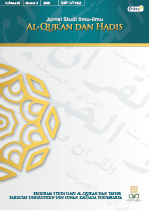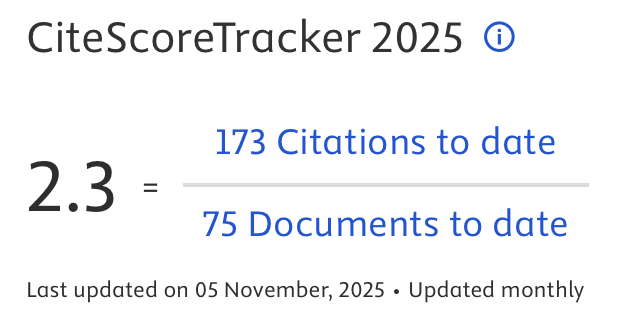Form, Consistency and Relevance of Dhabt in Qur’an Manuscript at Museum of Sunan Drajat Lamongan East Java
DOI:
https://doi.org/10.14421/qh.v23i2.3571Keywords:
Dhabt, Qur’anic Manuscripts, Al-Qur`an, CivilazationAbstract
The research was motivated by the development of ancient archipelago manuscripts which had not been widely enjoyed by academic reviewers. One of them is Qur’an Manuscript of Lamongan. This assumption is motivated by a statement stating that the Al-Qur’an in the archipelago has content in terms of text, namely written and in the same shape. The existence of Qur’an Manuscript manuscripts is not a problem and it is not even functioning. The primary data source uses Qur’an Manuscript manuscripts in the Sunan Drajat Lamongan Museum, and several other secondary sources that are related with the issue of the Mushaf and dhabt Al-Qur`an. Meanwhile, the data analysis method used is the structural analysis method, which describes and explains aspects of the work that produce comprehensive works. The results of this study show that the archaic archipelago manuscripts have similarities with the Indonesian Standard Mushaf from various aspects such as the affixing the punctuation of hamzah washal and hamzah qatha ‘, which are included in the breadfruit sign in the reading of izhar, idgham, ikhfa, iqlab in nun sakinah. Meanwhile, other punctuation marks have changed. The use of dhabt in Qur’an Manuscript Lamongan manuscripts from beginning to end experiences consistency, that is, the punctuation in the mushaf does not change shape. The existence of this ancient manuscript has several implications including: implications for the way of the Al-Qur’an, implications for interpretation, and implications that are informative. Such conditions are compiled from data generated from several well documented documentation. Meanwhile, if it is viewed from relevance, there is an inequality between Qur’an Manuscript Lamongan manuscripts and the Indonesian Standard Mushaf in the form of dots, i’rab (harakat rafa’, nashab, jar or jazem), naqish (less) or ziyadah (added) letters, tabdil (replacement letters or words), etc. So that it can force relevance will cause damage to the meaning in the reading of the Al-Qur`an.
 Abstract viewed: 791 times
|
Abstract viewed: 791 times
|
 PDF downloaded = 473 times
PDF downloaded = 473 times
References
Abidin, Zainal. Mushaf Nusantara, Jejak, Raga dan Para Penjaganya. Tangerang: Pustaka Compass, 2021.
Aceh, Abubakar. Sejarah Al-Qur`an. Yogyakarta: Ramadhani,1989.
Ahmad, Nur. Filologi Naskah Islam Nusantara. Semarang: CV. Lawwana, 2020.
__________ Wajah Islam Nusantara: Jejak Tradisi Santri, Aksara Pegon, dan Keberislaman dalam Manuskrip Kuno. Ciputat: Pustaka Kompas, 2020.
Asosiasi Ilmu Al-Qur`an & Tafsir di Nusantara. Ahmad Baidhowi (ed), Tafsir Al-Qur`an di Nusantara. Yogyakarta: Lembaga Ladang Kata, 2020.
Azra, Azyumardi. Jaringan Ulama Timur Tengah dan Kepulauan Nusantara Abad XVII dan XVIII: Akar Pembaharuan Islam Indonesia. Jakarta: Kencana Prenada Media Grup, 2013.
Al-A’zami, MM. Sejarah Teks Al-Qur`an dari Wahyu sampai Kompilasi Kajian Perbandingan dengan Perjanjian Lama dan Perjanjian Baru, translated by Sohirin Solihin dkk. Depok: Gema Insani, 2014.
Baidan, Nashruddin & Erwati Aziz, Metodologi Khusus Penelitian Tafsir, Yogyakarta: Pustaka Pelajar, 2016.
Barir, Muhammad. Tradisi Al-Qur`an di Pesisir Jaringan Kiai dalam Transmisi Tradisi Al-Qur`an di Gerbang Islam Tanah Jawa. Yogyakarta: Nurmahera, 2017.
Barir, Muhammad. Peradaban Al-Qur`an dan Jaringan Ulama Pesisir di Lamongan dan Gresik in Jurnal Suhuf 8, Nomor 2, 2015.
Birnbaum, Eleazar. “Persian Manuscripts in the Birnbaum Collection, Toronto. A Brief Catalogue” in Journal of Islamic Manuscripts, 2017.
Bongianino, Umberto. “A Rediscovered Almoravid Qur’ān in the Bavarian State Library, Munich (Cod. Arab. 4).” In Journal of Islamic Manuscripts 11, Nomor 3, 2020.
Bruinessen, Martin Van. Kitab Kuning, Pesantren dan Tarekat, terj. Farid Wajdidi dan Ika Iffati. Yogyakarta: Gading, 2012.
Darzi, Maedeh, Benjamin Stern, Howell G.M. Edwards, Alex Surtees, and Mohammad Lamehi Rachti. “A Study of Colourant Uses in Illuminated Islamic Manuscripts from the Qājār Period (1789–1925 C.E), Early Modern Iran” in Journal of Archaeological Science: Reports 39, 2021.
Déroche, François. “ Ahmed Moustafa and Stefan Sperl, The Cosmic Script: Sacred Geometry and the Science of Arabic Penmanship. Vol. 1: Sources and Principles of the Geometry of Letters; Vol. 2: From Geometric Pattern to Living Form” in Journal of Qur’anic Studies 21, no. 2, 2019.
Djunaedi, Wawan. Sejarah Qira`at Al-Qur`an di Nusantara. Jakarta: October, 2008.
Al-Farh, Sayyȋd Lȃsin Abȗ. Khȃlid bin Muhammad al-Hȃfiz al-’ilmiy, Taqrȋb al-Ma’ȃni fȋ Syarh Hirz al-Amȃniy fȋ Qirȃ’ah as-Saba’, Madinah: Dȃr az-Zamȃn, 2003.
Fathoni, Ahmad. Petunjuk Praktis Tahsin Tartil Al-Qur`an Metode Maisuro. Ciputat: Yayasan Bengkel Maisura, 2021.
______________Ilmu Rasm Usmani, tt: tt, 2013.
Fatoni, Sulthan. Peradaban Islam Desain Awal peradaban, Konsolidasi Teologi Konstruk Pemikiran dan Pencarian Madrasah . Jakarta: Elsas, 2011.
George, Alain. “Coloured Dots and the Question of Regional Origins in Early Qurans (Part I).” in Journal of Qur’anic Studies 17, no. 1 (February 1, 2015): 1–44.
Hakim, Abdul. “Metode kajian Rasm, Qiraat, Wakaf dan Dabt pada Mushaf Kuno.” in Jurnal Suhuf 11, no. 1 June , 2018.
Hamès, Constant. “Sura Headings and Subdivisions in Qur’an Manuscripts from Sub-Saharan Africa: Variations and Historical Implications.” in Journal of Qur’anic Studies 15, no. 3, 2013.
Lajnah Pentashihan Mushaf Al-Qur`an, Mushaf Kuno Nusantara: Jawa (Jakarta: Badan Litbang dan Diklat Kemenag RI, 2019.
Liebrenz, Boris. “Troubled History of a Masterpiece. Notes on the Creation and Peregrinations of Öljeytü’s Monumental Baghdad Qur’ān.” In Journal of Islamic Manuscripts, 2016.
Lubis, Nabilah. Naskah Teks dan Metode Penelitian Filologi (Jakarta: Yayasan Media Alo Indonesia, 2001.
Muhaisin, Muhammad Salim. Irsyȃd at-Thȃlibin ilȃ Dhabt al-Kitȃb al-Mubȋn, Kairo: Dȃr Muhsin, 2002.
Mursyid, Achmad Yafik. “Endonezya’daki Mushaf Basım Faaliyetlerinin Osmanlı Geleneksel Mushaflarıyla İlişkisi.” İlahiyat Tetkikleri Dergisi (2020).
Razak, Rajabi Abdul, and Idries Trevathan. “The 19th-Century Malay Qur’a¯n A Comparative Study of Materials and Techniques.” Journal of Islamic Manuscripts, 2010.
Syaifuddin & Muhammad Musaddad, “Beberapa Karakteristik Mushaf Al-Qur`an Kuno Situs Girigajah Gresik”, in Jurnal Suhuf 8, no. 1, 2015.
Sirojudin, Didin. Seni Kaligrafi Islam. Bandung: Rosda Karya, 2000.
Tim Peneliti dan Penyusun Buku Sejarah Sunan Drajat, Sejarah Sunan Drajat dalam Jaringan Masuknya Islam di Nusantara.
Tjandrasasmita, Uka. Arkoelogi Islam Nusantara, (Jakarta: Kepustakaan Populer Gramedia, 2009.
Wahyudi, Rudi. Penerapan Tarjih Rasm Utsmani dan Dhabt Al-Qur`an. Sukabumi: Farha Pustaka, 2020.
Wieringa, Edwin. “The Idea of an Old Qur’an Manuscript: On the Commercialization of the Indonesian Islamic Heritage.” Heritage of Nusantara: International Journal of Religious Literature and Heritage 3, no. 1 February 17, 2014.
Downloads
Published
How to Cite
Issue
Section
License
Copyright (c) 2022 Isyroqotun Nashoiha, Romlah Widayati

This work is licensed under a Creative Commons Attribution-NonCommercial-NoDerivatives 4.0 International License.
Publishing your paper with Jurnal Studi Ilmu-ilmu al-Qur'an dan Hadis means that the author or authors retain the copyright in the paper. Jurnal Studi Ilmu-ilmu al-Qur'an dan Hadis uses license CC-BY-NC-ND or an equivalent license as the optimal license for the publication, distribution, use, and reuse of scholarly works. This license permits anyone to copy and redistribute the material in any medium or format and must give appropriate credit, provide a link to the license, and indicate if changes were made. If you remix, translate, transform or build upon the material you may use it for private use only and not for distribution. Jurnal Studi Ilmu-ilmu al-Qur'an dan Hadis granted an exclusive non-commercial reuse license by the author(s), but the author(s) are able to put the paper onto a website, distribute it to colleagues, give it to students, use it in your thesis, etc, so long as the use is not directed at a commercial advantage or toward private monetary gain. The author(s) can reuse the figures and tables and other information contained in their paper published by Jurnal Studi Ilmu-ilmu al-Qur'an dan Hadis in future papers or work without having to ask anyone for permission, provided that the figures, tables, or other information that is included in the new paper or work properly references the published paper as the source of the figures, tables or other information, and the new paper or work is not direct at a private monetary gain or commercial advantage.
Jurnal Studi Ilmu-ilmu al-Qur'an dan Hadis journal Open Acces articles are distrubuted under the Creative Commons Attribution-NonCommercial-NoDerivatives 4.0 International (CC BY-NC-ND 4.0). Article can be read, copy and redistribute the material ini any medium or format under the following conditions:
Attribution — You must give appropriate credit, provide a link to the license, and indicate if changes were made. You may do so in any reasonable manner, but not in any way that suggests the licensor endorses you or your use.
NonCommercial — You may not use the material for commercial purposes.
NoDerivatives — If you remix, transform, or build upon the material, you may not distribute the modified material.










